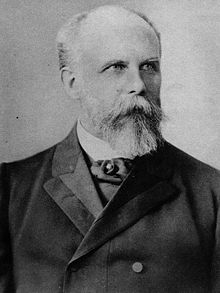William Thierry Preyer 1841 - 1897
June 17, 2010
 {::}**William
Thierry
Preyer** 1841
{::}**William
Thierry
Preyer** 1841
- 1897 was an English physiologist, Lecturer in Zoophysics and Zoochemistry at the University of Bonn, Professor of Physiology and Director of the Physiology Institute at the University of Jena, and the founder of the two sciences of developmental psychology and developmental physiology,
Preyer was a friend of Charles Darwin, a supporter of Charles Darwin’s _The Origin of Species, _Preyer awarded Charles Darwin an Honorary doctorate from Jena University,
Preyer, like Charles Darwin, also experimented with ultra low dilutions, discovering that he could paralyse frogs with 0.000005 gms of curare (5 millionths of a gram) (Anon, The Pacific Coast Journal of Homeopathy, Volume 11, (California State Homoeopathic Medical Society, 1903). Page 219. See also Anon, Glasgow Medical Journal, Volume 15, (Glasgow and West of Scotland Medical Association, Royal Medico-Chirurgical Society of Glasgow, 1881). Page 410. See also Anon, Collected reprints on research by grantees, Volume 9, Part 1, (National Foundation for Infantile Paralysis, 1948). Multiple pages. See also Alexander Wynter Blyth, Meredith Wynter Blyth, Poisons; their effects and detection, (C. Griffin & company, limited, 1920). Page 428). *‘… Two days afterwards a third frog was similarly treated with the urine of the second ; in thirty minutes it was motionless. Then the urine of the third frog **… *Here we have the contents of the bladder of the rabbit which we previously killed with curare… W. Preyer, ’ Allgem. Wiener med. Ztg.,’ 1879… (Carl Binz, _Lectures on pharmacology for practitioners and students, Volume 1,_ (The New Sydenham Society, 1895). Page 125)’
Preyer was a colleague of Gustav Theodor Fechner (who was an advocate and patient of homeopathy),
Preyer also provided data for the homeopathic proving of hydrocyanic acid in 1870, and provided proving data for Richard Hughes’s A Cyclopaedia of drug pathogenesy *(Thomas Lindsley Bradford, [Index to Homeopathic Provings*](http://books.google.co.uk/books?id=62KubRk45c0C&pg=PA157&dq=preyer+homeopath&hl=en&ei=NyQaTO6-DNGP4gbs8-3ECg&sa=X&oi=book_result&ct=result&redir_esc=y#v=onepage&q=preyer&f=false), (reprinted by Lightning Source Incorporated, 30 May 2009)).
In 1866 he earned his medical degree at the University of Bonn, and in 1869 succeeded Johann Nepomuk Czermak as professor of physiology at the University of Jena. At Jena he was also director of the physiology institute.
Preyer was a founder of scientific child psychology, and a pioneer concerning research of human development that was based on empirical observation and experimentation.
He was inspired by Charles Darwin’s theory of evolution and Gustav Theodor Fechner’s work in psychophysics.
He published two landmark works; a book on developmental psychology called Die Seele des Kindes (The Soul of the Child), and a book on developmental physiology titled Specielle Physiologie des Embryo (Special Physiology of the Embryo). Both works laid the foundation in their respective disciplines regarding future study of modern human development.
At Jena, Preyer introduced experimental-scientific training methods into his lectures, and also created seminars on physiology. Today, the “William Thierry Preyer Award” is issued by the European Society on Developmental Psychology for excellence in research of human development.
While still a student Preyer traveled to Iceland with the geologist Ferdinand Zirkel. The results of their journey were published in 1862.
Turning from natural science to medicine, Preyer studied in Paris with Claude Bernard and Charles Adolphe Wurtz, and later in Berlin, Vienna, and Bonn.
In 1865 Preyer qualified at Bonn as a lecturer in zoophysics and zoochemistry in the Faculty of Philosophy. The following year he received his medical degree at Bonn.
Preyer’s initial scientific work dealt with physiological chemistry (hemoglobin, gases in the blood, and curare) and sense physiology (myophysical law). His lactic acid theory of sleep (1876) became widely known.
In 1867 he qualified as a teacher of physiology at the Faculty of Medicine of the University of Jena, where in 1869 he succeeded Johann Nepomuk Czermak as Professor of Physiology and was appointed Director of the Physiology Institute.
Poor health obliged him to retire in 1888, and he spent the rest of his life as a private scholar in Wiesbaden.